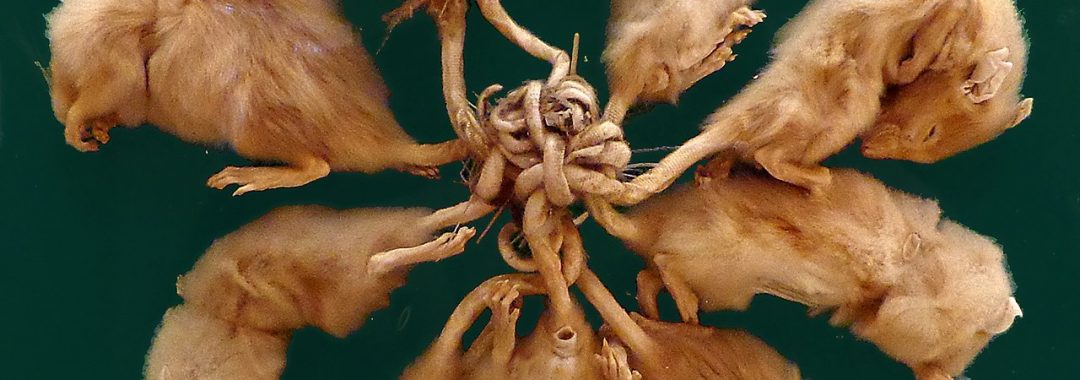The first Rat King was documented in 1564 in Germany, the last in 2005 in Estonia. There were 61 cases during this time. A Rat King (from the German Rattenkönig) is a collection of black rats (rattus rattus) tied together by their tails such that they take on the appearance of a single creature. The number of rats knotted together typically varies between 5 to 12, although the famous Rat King of Buchheim consisted of 34 young rattus rattus who were discovered dead. The majority of Rat Kings are, however, found alive, but are often killed on discovery, normally through boiling water or drowning. A number of preserved remains exist, including the noted Rat King of Dellfield, which may still be viewed on display in the Strasbourg Zoological Museum. But many specimens have been sadly lost or destroyed in the Second World War. This makes it difficult to draw any firm conclusions about the nature and life of a Rat King.
Rat Kings, like many rattus rattus, appear to live close to human habitation. They are typically discovered under floorboards, behind walls or in cellars. Whilst there are cases of ‘fake’ Rat Kings (and also instances of Squirrel Kings), most are considered to be ‘natural’. By which is meant that the knotting of their tails occurs through some activity in which the members of the Rat King have engaged in by themselves rather than as a direct consequence of human intervention. It is generally considered that Rat Kings are ‘formed’ rather than ‘born’, since there are cases of Rat Kings made up of adult rattus rattus, such as the great Rat King of Berlin, found in 1860. Given the difficulty of imagining the life experience of creatures so cruelly bound to one another, it must be supposed that Rat Kings become such at a time relatively proximal to their witnessing by humans.
It is a curious matter that so many Rat Kings have been found in the regions of Germany, in places such as Großballhausen, Wundersleben and Döllstadt (where two were reported in the same year of 1822). This has led some commentators to suspect that the Rat King is a cultural symbol, specifically of the relationship between identity and territory. The greatest number of Rat Kings were documented during the periods from the mid-fifteenth to the early seventeenth centuries where Prussia and subsequently modern Germany was in the process of being formed. The Rat King is a symbol of both profound otherness and of the difficulties of living together. It is ancient, marking the long history of co-existence between humans and rattus rattus (commonly, but erroneously, regarded as the Plague Rat), yet also modern, in that it starts to appear in rural communities at the moment when they are just beginning to be swallowed into urban conglomerations. Perhaps we might say that, conceptually, the Rat King is the pain of entanglement, a material thinking through of the impossible reality of collectivity.
[This piece draws substantially upon Martin Hart’s (1962) Rats. London: Allison Busby and Adrian Daub’s (2019) All hail the Rat King. https://longreads.com/2019/12/11/rat-kinggermany-nutcracker/]Author: Steven D. Brown
